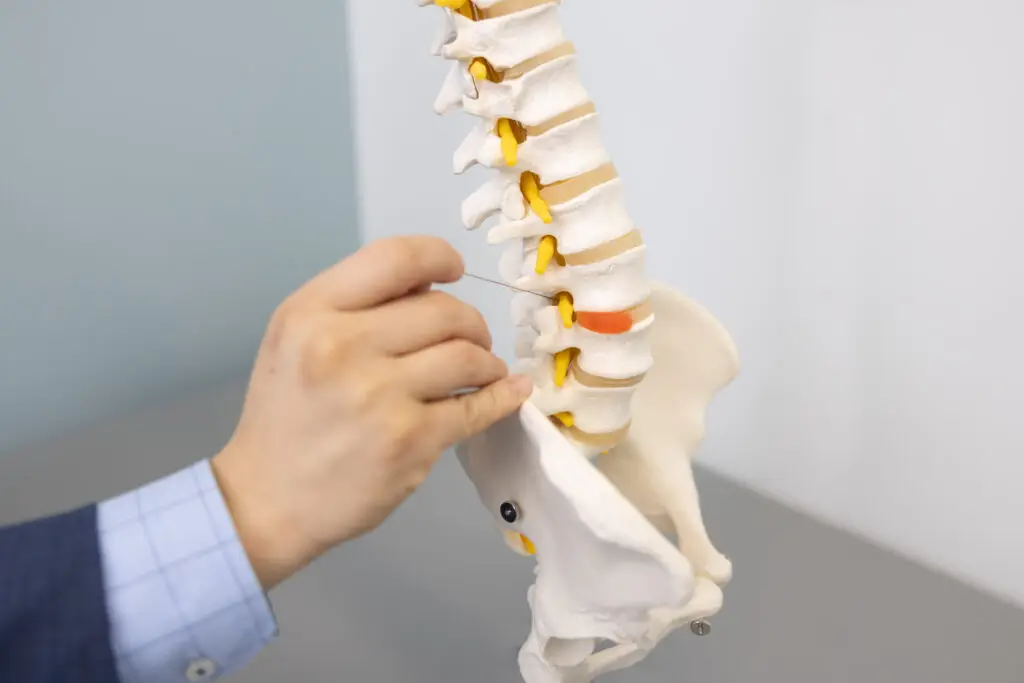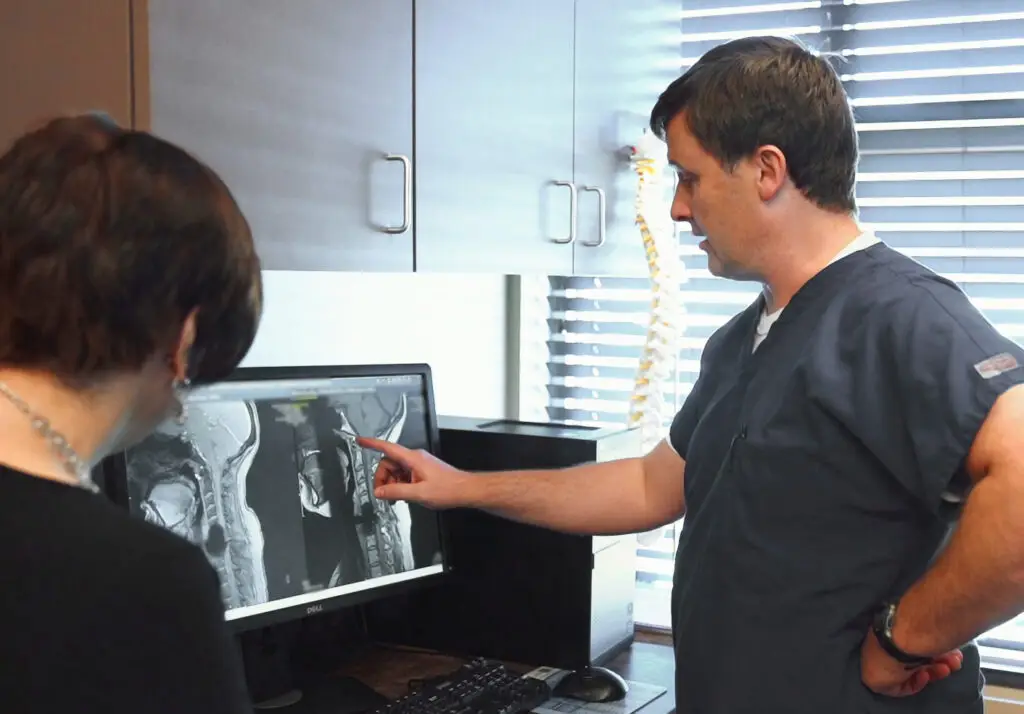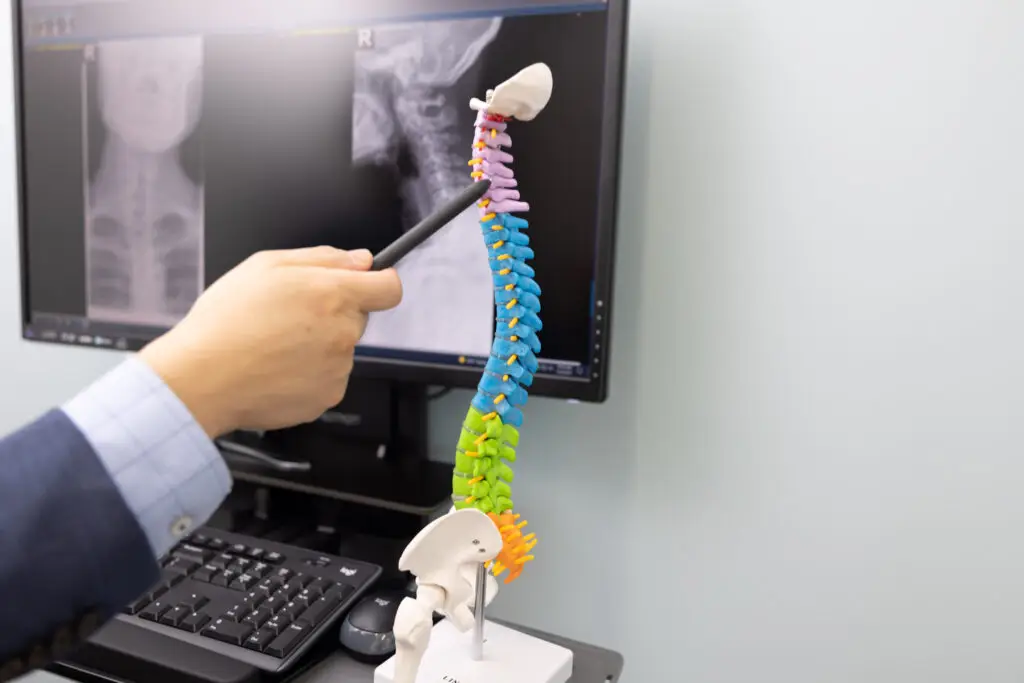What Is an Epidural Steroid Injection and When Is It Used?
how we can help
Epidural Steroid Injection Overview
When spinal conditions from age-related wear and tear, injuries or disease cause urgent and severe pain, the quickest way to alleviate this is by applying medicine into the spine via a syringe. This is called an epidural steroid injection. It is sometimes referred to as an epidural corticosteroid injection.
This medicine is injected into the epidural area which is a fat-filled area that covers the spinal cord to protect it and the surrounding nerves from damage. The epidural space is between the dural sac (a membrane encasing the spinal cord, spinal fluid, and nerve roots) and the vertebral wall, inside the spinal canal but outside the spinal nerve and sac.
Table of Contents
Treats
Types
Recovery
What is an Epidural Steroid Injection?
An epidural steroid injection (ESI) is an injection that delivers long-acting steroids directly into the epidural space. The steroids help to reduce pain by reducing inflammation around the nerves. Sometimes an anesthetic or saline is also used to help “flush out” inflammatory agents that may be irritating a nerve.
If a patient has intense, difficult-to-treat pain in his or her legs or arms from inflamed spinal nerves, then an epidural steroid injection might give them quick relief. Often, nerve passages from the spine to your arms or legs become narrowed, causing this pain. This narrowing can cause inflammation of the spinal nerves.
A few of these conditions may add to this narrowing, including:
- Herniated disks
- “Slipped” vertebrae
- Spinal stenosis
- Joint cysts
- Bone spurs
- Thickening ligaments in the spine because of spinal arthritis
Injected steroids reduce inflammation to provide pain relief.
Other common names for an epidural steroid injection include:
- ESI injection.
- Spinal injection for back pain.
- Back pain injection.
- Steroid injection — epidural.
- Steroid injection — back.
While this procedure appears similar to that which can be used for lessening pain from labor and childbirth, epidural steroid injections are not the same as epidural anesthesia or analgesia. Those types of epidurals used during delivery involve an injection of local anesthetic medication into the epidural space, which numbs certain regions of your body.
There is no definitive research to dictate how often a patient should have epidural steroid injections. In general, it is considered reasonable to perform up to three epidural steroid injections per year, but no more than four during this period. The decision to do a series of injections is usually based on the patient’s response to the first epidural steroid injection procedure done.

Patients Ask:
Can an epidural steroid injection be used to reduce pain in all three sections of the spine - cervical (neck), thoracic (middle) and lumbar (low)?
Texas Back Institute Responds: Yes. This procedure involves the delivery of pain medication to the epidural space by directing a needle between two adjacent vertebrae. The goal of this interventional pain medicine procedure is the relief of radicular pain and may be performed in the cervical, thoracic, or lumbar spine. The medicine is typically composed of a combination of anesthetics and steroids. The interlaminar approach allows for medication to spread over a larger area than transforaminal epidural injection and can be advantageous in patients with multi-level spinal pathology.

How Do Epidural Steroid Injections Work?
This procedure is a non-surgical approach to pain management. In every case, the Texas Back Institute spine specialists use surgery as the final patient treatment option, and epidural steroid injections are part of the arsenal of conservative, non-surgical procedures they use.
The physician injects a steroid or corticosteroid medication using fluoroscopy (x-ray guidance) into the epidural space around the spinal cord. This cord consists of a group of nerves that runs from the brain to the lower back. The spinal cord acts as a type of “highway” that connects the nerves located all over the body to the brain. This allows the brain to send signals and communicate with the rest of the body.
The epidural space surrounds the spinal cord like a sleeve and contains fat, the dural sac, spinal nerves, blood vessels and connective tissue. The spine, which is sometimes called the backbone, is composed of a column of many small bones called vertebrae. These bones help protect the spinal cord from injury. Between the vertebral bones are disks – which are similar to “shock absorbers” in vehicles – that provide cushioning for the vertebrae and flexibility for the individual.
In some cases, usually due to age-related wear and tear or perhaps injuries, nerve roots that are attached to the spinal cord can become pinched or inflamed. A good example of this is a herniated disk. Inflamed nerves can cause pain, and the pain may radiate down your arm, buttocks and/or legs depending on where the inflamed nerve root is along your spine.
With an epidural steroid injection, the steroid coats the irritated nerve(s) that are causing the pain and works to reduce swelling and pressure on the nerves. The steroid allows the nerve(s) time to heal. In some cases, epidural steroid injections can provide patients with long-term or permanent pain relief. ESIs can also sometimes identify the painful nerve.
Patients Ask:
How long does an epidural steroid injection take to complete and what is the recovery time from this procedure?
Texas Back Institute Responds: The epidural steroid injections usually take between 10 and 15 minutes to complete. Following the steroid injection, the patient is usually monitored 30 minutes before being discharged to go home. It is important that the patient has someone drive him/her home after the steroid injection. Patients are usually asked to rest on the day of the injection. However, normal activities (those that were done the week prior to the injection), including work, may typically be resumed the following day. Please note that your back may be sore for 24 to 48 hours.
What Are the Side Effects of Epidural Steroid Injections?
These injections have a long history of efficacy and safety. Epidural steroid injection has become a common treatment option for patients with low back pain or sciatica. The first injections were given around 1900 in Paris by Jean Sicard (1872-1929) and Fernand Cathelin (1873-1945), who worked independently. They both injected small volumes of cocaine into the sacral hiatus. In a relatively short time, the epidural treatment of back pain and sciatica gradually spread to other parts of Europe and Northern America.
In the early 1950s, corticosteroids were introduced for epidural use. Since the 1970s, there have been numerous clinical trials that show a significant effect of epidural corticosteroid injections compared with placebo for leg pain in the short term. Of course, any medical procedure has the possibility of side effects and complications. Some general side effects of these include:
- “Steroid flush,” or flushing of the face and chest, with warmth and an increase in temperature for several days
- Sleeping problems
- Anxiety
- Menstrual changes
- Water retention
- In rare instances, pain that increases for several days after the procedure
Some more specific sides effects may include:
- There will be minimal low-level radiation exposure due to the X-rays. Fluoroscopy X-rays may be harmful to unborn babies. It’s essential to tell your healthcare provider if you’re pregnant or might be pregnant before you undergo the procedure. Oftentimes, a urine pregnancy test will be administered before the procedure.
- If the patient has diabetes, an epidural steroid injection will likely cause high blood sugar, which is also called hyperglycemia. This could last for hours or even days.
- If the patient has glaucoma, an ESI may temporarily increase their blood pressure and eye pressure.
The spine specialist at Texas Back Institute notes that serious complications from epidural steroid injections are rare but can include:
- Allergic reaction
- Bleeding
- Nerve damage
- Infection
- Paralysis


(insert YouTube video on types of injections )
How Do Epidural Steroid Injections Differ from Facet Joint Injections?
Conservative spine care includes several injections that are used for pain management. Some patients wonder about the difference between epidural steroid injections and facet joint injections. Make no mistake, they are different procedures for different conditions of the spine.
According to the spine experts at Texas Back Institute, facet joints are the connections between the bones of the spine. The nerve roots pass through these joints to go from the spinal cord to the arms, legs and other parts of the body. These joints also allow the spine to bend and twist, and they keep the back from slipping too far forward or twisting without limits.
Facet joint treatments target what we call axial pain, which means pain only in the neck or back and not radiating pain into the arms or legs. In most cases these injections are indicated for patients with pain that occurs due to arthritis conditions or injury to the facet joints.
Conversely, epidural injections are used to treat pain that radiates from the spine to other parts such as the arm or leg. It is useful in managing chronic pain that occurs due to a specific nerve being inflamed or pinched.
Here’s a brief look at the types of injections used for pain management.
Patients Ask:
What is the best position to sleep after an epidural steroid injection?
Texas Back Institute Responds: Getting a good night’s sleep is important for a quick recovery from epidural steroid injections. Sleeping on one’s side can significantly reduce pressure on the injection site, especially during the initial recovery phase after a fresh epidural sac injection. By reducing pressure on the injection site, side lying helps to reduce pain and promote wound healing.
The Different Types of Epidural Steroid Injections

Epidural steroid injections are usually classified by their location along the spine — cervical, thoracic or lumbar — and by the path of the needle to get to the epidural space — interlaminar, transforaminal or caudal.
There are three types of ESIs based on which section of your spine the Texas Back Institute surgeon injects the medication. These include:
Cervical Epidural Steroid Injection (neck)
With the cervical ESI, the needle entry site is slightly to the side of the spine in the neck. If the patient has pain in his or her neck which radiates down their arms from a herniated disk, bone spur or stenosis, Texas Back Institute physicians may recommend a cervical ESI.
Thoracic Epidural Steroid Injections (upper and middle back)
For thoracic epidural steroid injections, the needle entry is slightly to the side of the spine in the upper or middle back. If the patient has pain in his upper or middle back from a thoracic disk herniation or thoracic spinal stenosis, Texas Back specialists may recommend a thoracic ESI.
Lumbar Epidural Steroid Injections (low back)
With this procedure, the needle entry site is slightly to the side of the spine in the low back which is also known as the lumbar region. Patients with lower back and leg pain from a lumbar herniated disk, lumbar degenerative disk disease or lumbar spinal stenosis, can be prescribed a lumbar epidural steroid injection.
There are several ways to reach the epidural space surrounding the spinal nerves which are causing the pain. These epidural steroid injections explain the path the needle takes in order to reach to the epidural space:
Caudal Epidural Steroid Injections (the sacrum)
This type of ESI has the path of the needle going through the sacral hiatus, which is at the bottom of the sacrum and just above the tailbone, to reach the lowest spinal nerves. The sacrum is the triangular bone in the lower back that’s situated between the hip bones.
Interlaminar Epidural Steroid Injections (between the lamina)
With this injection, the path of the needle is between two laminae in your spine to get to the epidural space. A lamina is the flat plate of bone that’s part of each vertebra in the spine. The laminae in the spine form the outer wall of the spinal canal and protect the spinal cord.
Transforaminal Epidural Steroid Injections (across the foramen)
Foramina are the openings through which the spinal nerve roots can exit the spine. For a transforaminal ESI, the path of the needle is through the foramina.
Pain Relief with Non-Surgical Procedures

The spine experts at Texas Back Institute are dedicated to patient care and, in most cases, this care is non-surgical. Epidural steroid injections are just one of many conservative care options available to patients. If back pain is affecting your quality of life, maybe it’s time to see what can be done about this. Click here and set an appointment now.
Learn more
Frequently Asked Questions
Yes. This procedure involves the delivery of pain medication to the epidural space by directing a needle between two adjacent vertebrae. The goal of this interventional pain medicine procedure is the relief of radicular pain and may be performed in the cervical, thoracic, or lumbar spine. The medicine is typically composed of a combination of anesthetics and steroids. The interlaminar approach allows for medication to spread over a larger area than transforaminal epidural injection and can be advantageous in patients with multi-level spinal pathology.
The epidural steroid injections usually take between 10 and 15 minutes to complete. Following the steroid injection, the patient is usually monitored 30 minutes before being discharged to go home. It is important that the patient has someone drive him/her home after the steroid injection. Patients are usually asked to rest on the day of the injection. However, normal activities (those that were done the week prior to the injection), including work, may typically be resumed the following day. Please note that your back may be sore for 24 to 48 hours.
Getting a good night’s sleep is important for a quick recovery from epidural steroid injections. Sleeping on one’s side can significantly reduce pressure on the injection site, especially during the initial recovery phase after a fresh epidural sac injection. By reducing pressure on the injection site, side lying helps to reduce pain and promote wound healing.
Locations


